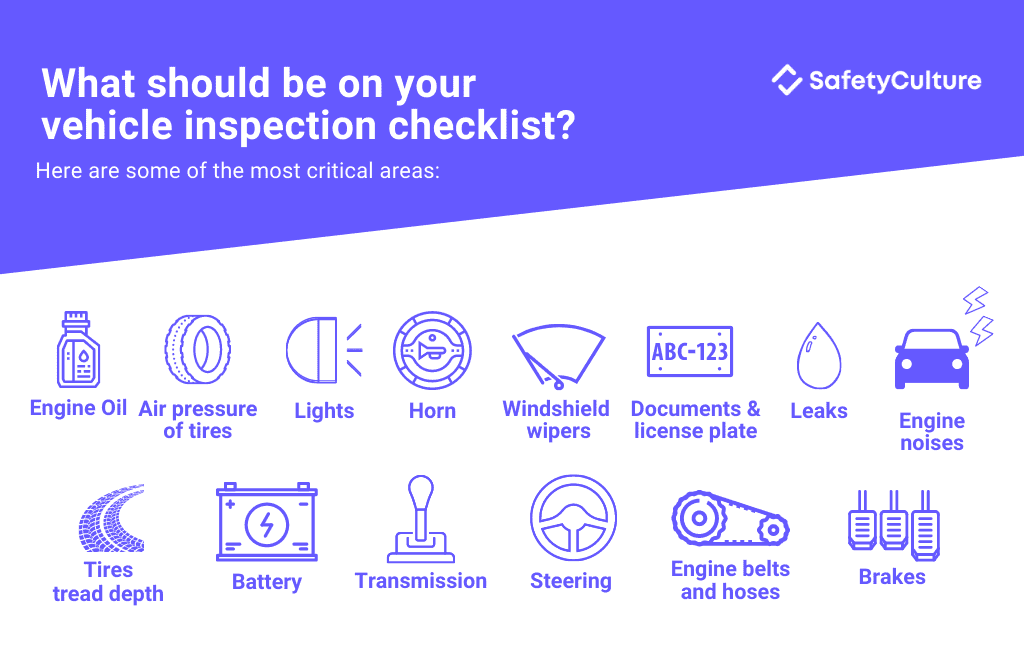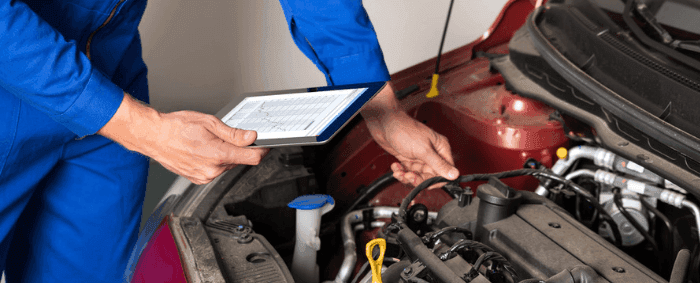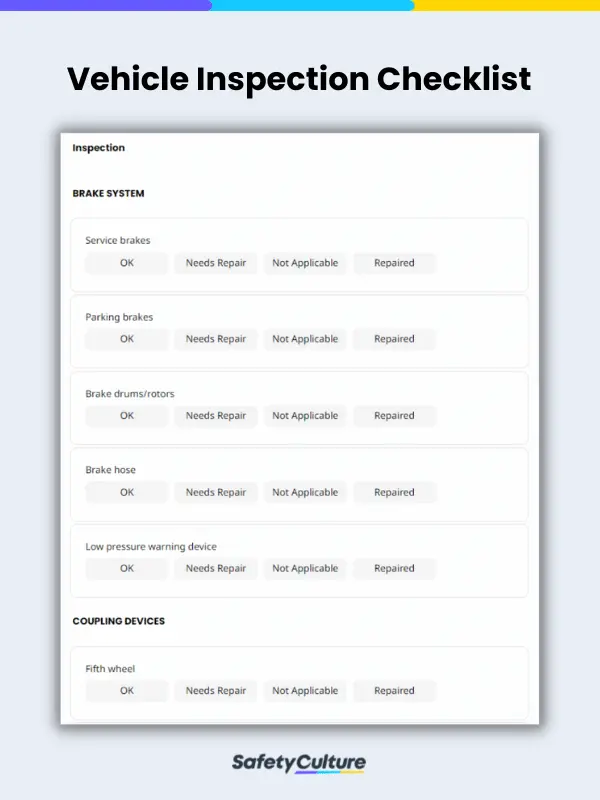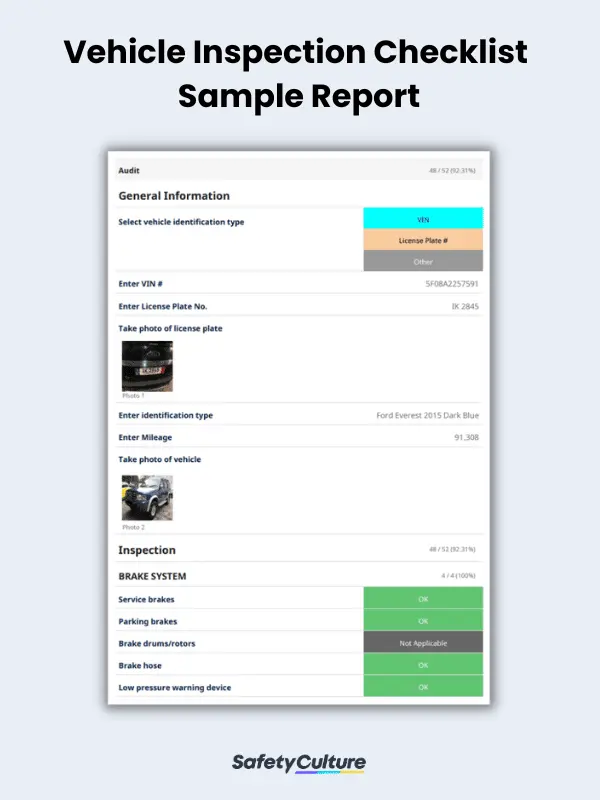What is a Vehicle Inspection Form?
A vehicle inspection form is a document detailing a vehicle’s condition. This document is used both as verification of a vehicle’s roadworthiness and as a guide for drivers, mechanics, and safety officers in performing vehicle inspection. Performing pre-start checks and regular vehicle inspections proactively reduces risks of accidents and operational downtime.
Importance
Road safety is a major concern for everyone on the road, as unexpected vehicle accidents and issues can result in injuries, fatalities, and significant property damage. To help mitigate risks, having and using a vehicle inspection checklist has become important before, during, and after a vehicle is used.
With a vehicle inspection checklist suited to your needs, you not only reduce the risk of accidents but also contribute to overall road safety. Regular inspections with the use of a checklist can help identify potential issues with your vehicle’s brakes, tires, lights, and other critical components. Addressing these problems promptly can prevent breakdowns and accidents caused by faulty vehicle parts, as well as extend its lifespan.
Having a dedicated checklist for vehicle inspections can also make it easier to track and record changes and issues, as everything will be documented in one place. With a digital checklist in particular, you can store all findings in the cloud, making it easy to access anytime and anywhere.
What Items Should be on the Vehicle Inspection Checklist?
A vehicle inspection checklist is used to evaluate a vehicle’s working condition, and sometimes for a Driver Vehicle Inspection Report (DVIR). It aims to identify mechanical issues or defects to ensure that vehicles are in good working order and safe for use on the road. Federal laws require vehicle owners to conduct daily inspections to limit the occurrence of accidents on the road.

The basic aspects of a car that needs to be inspected and included in your vehicle inspection checklist include the tires’ tread depth, the vehicle battery status, its transmission levels, its steering, engine belts and hoses, and brakes.
However, there are also some areas or items in the vehicle that should be inspected daily, below are some areas that should be included in a vehicle inspection checklist:
Engine oil
Use an oil dipstick to determine where the level is at, and if you should refill. Ensuring that engine oil is at the right level mitigates the risk of overheating which can result in costly repairs. It’s also one of the effective ways to maintain your engine and keep it engine healthy.
Air pressure of tires
Check tires visually before use and see if they are properly inflated because incorrect tire inflation may cause excessive wear or damage to the part. Also, look out for any signs of damage and unusual wear. Checking these daily does not only ensure safety on the road but also prolongs the life of your vehicle.
Lights
Check if the headlights, tail lights, and signal lights are all in proper working condition. This is crucial as some of these lights ensure the vehicle’s visibility to other drivers and these are especially important in situations with low visibility.
Horn
Confirm if horn works as it helps avoid collisions or other forms of accidents by making other drivers and pedestrians aware that a vehicle is nearby. If the horn isn’t functioning properly, try to investigate further since it can be a case of a bum horn or a poor ground connection.
Windshield & wipers
Ensure that there is enough water in the wiper system and check the blades regularly to keep windshield glass free of obstruction. Wiper blades do wear over time so if blades are cracked, worn, or otherwise damaged they should be repaired or replaced as necessary.
Vehicle documents & license plate
Make sure that vehicle documents are stored safely in the glovebox so they are easily retrievable whenever needed. Ensure that your license plate is clean, not obscured nor obstructed—this is to avoid license plates being deemed illegible and needing to be replaced altogether.
Engine noises
Examine engine noises as these are a great early indicator of potential bigger issues in a vehicle. Some of the common causes of abnormal engine noises include improper timing, incorrect octane, or lean air/fuel ratio. If knocking or tapping is noticed from a cold start then it could be an indicator of a serious defect.
Leaks
Scan the vehicle’s vicinity and check whether there are any leaks in or around it. The color and location of the leak can help diagnose the problem, but leaks can indicate serious problems so if any leaks are spotted then it’s important to ensure the vehicle is checked by a professional.
Sample Vehicle Inspection Report
Here is a vehicle inspection checklist in use for reference:
This checklist for vehicle inspection is printable and can be used in both PDF and digital formats.
Difference between Multi-point Inspection Checklist and Vehicle Inspection Checklist
When it comes to maintaining your motors, cars, trucks, and other vehicles, you are likely to hear of two checklists, namely a vehicle inspection checklist and a multi-point inspection checklist. In general, both identify issues with the vehicle before they turn into bigger, more expensive problems. The real difference lies in the way people typically use each term when referring to vehicle assessments.
While a “vehicle inspection” can be both quick and short, as well as extensive and time-consuming, a multi-point inspection exclusively refers to a thorough and comprehensive assessment of a vehicle’s condition. For example, since a daily vehicle inspection checklist is designed to be used every day, it is perfectly acceptable for it to cover only a few key areas; most of them concerning safety. Multi-point inspections, however, assess the vehicle in its entirety. This can be quite time-consuming which is why they are fewer and farther between.
The recommended frequency in which to conduct multi-point inspections with a vehicle inspection app may vary. To be safe, it is best to perform multi-point inspections on vehicles that come in for repair or maintenance work to ensure that nothing critical is missed.
FAQs about Vehicle Inspection Checklists
A vehicle inspection checklist is crucial for maintaining safety standards, identifying potential issues, and ensuring compliance with legal requirements. By enumerating all the items to check, this form helps ensure that inspectors won’t miss any necessary areas that need assessment. It also helps prevent accidents, breakdowns, and costly repairs.
Vehicle inspection checklists are used by various individuals and organizations, including drivers, vehicle owners, mechanics, fleet managers, and regulatory authorities. They are typically employed during preventative inspections to check any potential hazards before going on the road, and during regular vehicle assessments to maintain safety and longevity.
- Start by providing basic information such as the name of the client, location, name of inspector, and date of inspection.
- Enter vehicle-specific details including VIN number, plate number, and vehicle identification type.
- Assess each vehicle features that are listed on the vehicle inspection form and answer them according to the specific response type.
- Attach images or videos to the inspection for better visibility and details on the report.
- Add recommendations and overall rating for the vehicle inspected.
- Complete the inspection checklist by providing the necessary signatures.




